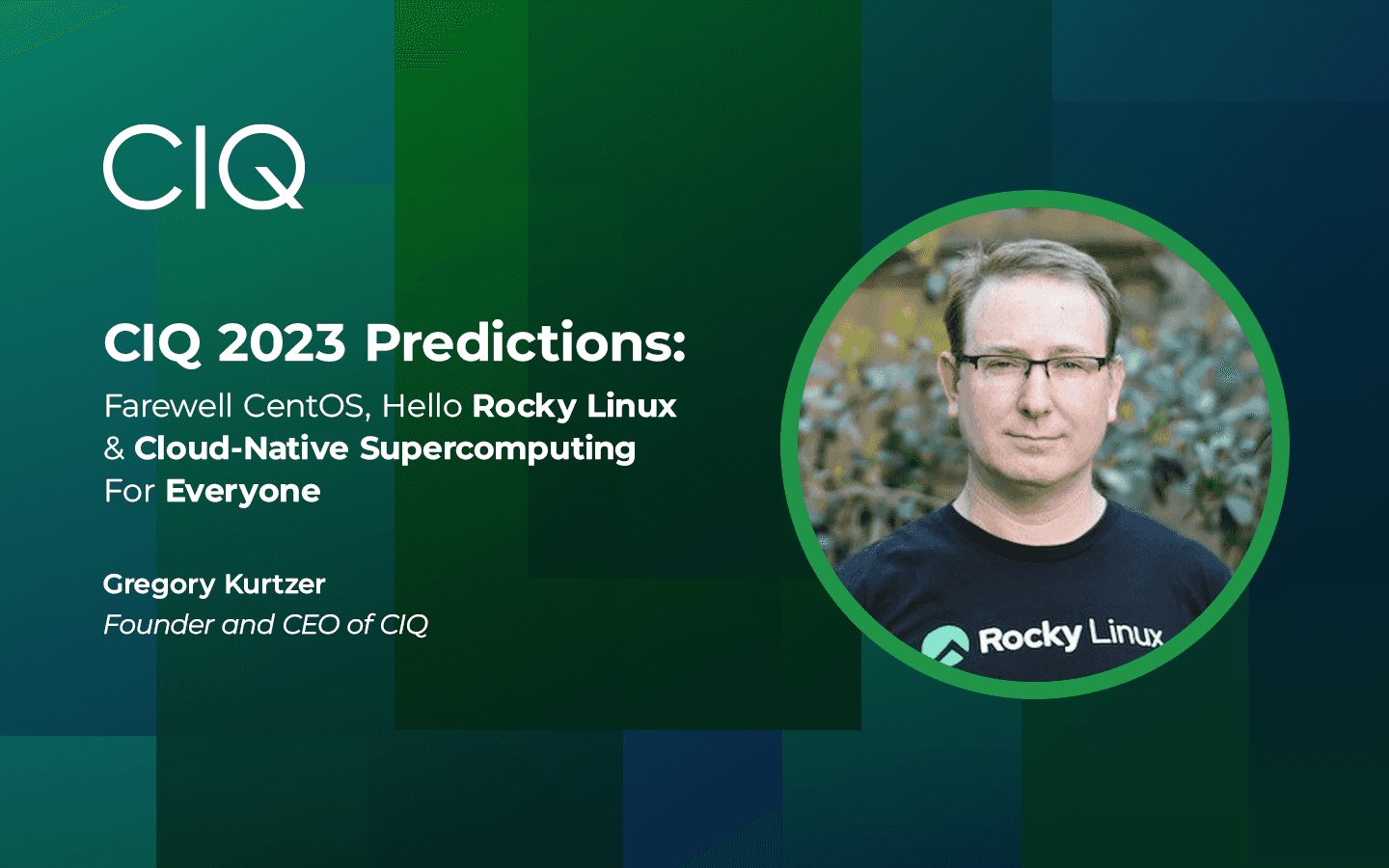4 min read
CIQ 2023 Predictions: Farewell CentOS, Hello Rocky Linux

Editor’s note: This blog post was originally published on the VMblog.com web site.
Despite all the headlines I’m reading that scream “uncertainty,” I don’t feel any dread about the future, at least in the area that has captured my professional passion. In fact, I am actually quite confident that 2023 will deliver some very positive advancements, and I’m looking forward to the year ahead. If you are interested in the world of enterprise-grade infrastructure or performance intensive computing, here are two predictions that are “money in the bank”:
-
In 2023, Rocky Linux—the free, open source Enterprise Linux operating system coupled with reliable and fine-tuned support models that drive down infrastructure costs—will be embraced as the replacement for CentOS that enterprises need for physical, cloud, virtual, and containers.
-
In 2023, we’ll see new tools that harness the power of containers, along with new ways to securely and easily automate software deployment, supply chain security, and lifecycle management at scale, transforming and modernizing performance intensive computing architectures for HPC/supercomputing and enterprise use-cases.
Farewell CentOS, Hello Rocky Linux
Two years ago, Red Hat decided to end-of-life CentOS, an open source enterprise Linux distribution. At the time, CentOS, which had been around for 18 years, was the No. 1 Linux distribution in the enterprise and had a huge following, including some of the most well-recognized companies in the world (Toyota, Disney, Verizon, and many, many more). CentOS was also the distribution of choice for most organizations building performance intensive computing architectures, including big data analytics, artificial intelligence and machine learning. So to say the decision to end-of-life CenOS was a shock to the ecosystem would be an understatement. It was certainly a shock to me, as one of the original founders of CentOS in 2004.
CentOS users were abruptly left empty handed, looking for an alternative Enterprise Linux distribution that was free, reliable, secure, and well-supported for the long-term, safe from the dictates of a single corporate entity. That’s when I decided to build another community-based free Enterprise Linux operating system, and the result was Rocky Linux. Rocky Linux was designed to deliver the value of CentOS, but with a governance structure that intentionally makes it virtually impossible for one company to take over the project. (You can read more about that structure and the Rocky Enterprise Software Foundation here.)
As we enter 2023, I can confidently state that the world can now say goodbye to CentOS and embrace Rocky Linux as their open source Linux distribution of choice. The migration is already well underway; an Hyperion Research study conducted this year indicated 72.1% of CentOS users planned to migrate from CentOS to another operating system and Rocky Linux is already at a 20.6% overall adoption (and even higher in the government sector, where Rocky Linux is at a 37.5% adoption rate). The Rocky Linux community has worked hard to help former CentOS users overcome the hassle they’ve experienced and emerge with a rock-solid Linux distribution they can count on for the long run. Recipient of HPCwire’s Readers’ Choice award for “Top 5 New Products or Technologies to Watch,” Rocky Linux is already among the most frequently adopted Linux distributions. According to metrics tracked by the Extra Packages for Enterprise Linux (EPEL) Special Interest Group (SIG), Rocky Linux adoption is outpacing all other Enterprise Linux variants. Since the project was launched, there have consistently been over 250,000 downloads per month, and project growth continues rapidly, with some of the largest names in enterprise cloud computing stepping up as supporters of the community, including AWS, Microsoft Azure, Google Cloud and VMware.
Most recently, Rakuten Symphony threw its full support behind Rocky Linux, because it meets the performance and economic needs of large, disaggregated and open telecom 5G+ network deployments.
In 2023, we’ll see the migration away from CentOS continue to the point where CentOS will become an artifact of the past, and Rocky Linux will clearly emerge as its leading replacement. As such, Rocky Linux will serve as the backbone of enterprise and professional infrastructure, multi-node environments, HPC clusters, and AI running in multi-node environments, where we will see another transformation in 2023…
New Tools Will Simplify Performance Intensive Computing (PIC) Complexity
Containerization has simplified software deployment with its “write once, run anywhere” capabilities. Enabled by technologies like Docker, Apptainer (formerly Singularity), and Kubernetes, containerization also has empowered users to deploy the software they need to do their jobs without requiring the time and talent of infrastructure engineers.
But the scale of containerization in PIC leads to a unique quandary of container complexity. Researchers find themselves managing anywhere from 100 to 1,000 of compute nodes or more at a time, which typically means they are devoting too much of their time to system administration and too little to research. As my colleague Glen Otero, Director of Scientific Computing, Genomics AI and Machine Learning at CIQ, described, “You don’t start out thinking, ‘I’m going to get into system administration of clusters. You start out as somebody who’s going to go do something huge in science. But you wind up in this space, because – we joke about it – you volunteered to set up the system. And then once you did, it’s like, ‘Hey, can you also do this? Can you also do that?’ And then you wake up one day and you’re like, ‘Where did my life go? I was supposed to do research.’”
Fortunately, a new wave of simplification is on the rise in PIC. In 2023, we will see rising adoption of tools that simplify the containerization of code and curtail the need for highly skilled (and expensive) developers to create custom builds. We demonstrated this capability earlier this year by using open source Apptainer to containerize OpenRadioss, subsequently deploying the code successfully on a crash model for the Toyota Camry. Another major improvement comes in the form of cluster management and provisioning, using open source tools like Warewulf.
Addressing the needs of both traditional PIC solutions and cloud-native supercomputing, this new wave of containerization and more advanced automation will unleash productivity, integration, and supply chain security across the PIC ecosystem. This ecosystem includes not only scientific research organizations but also a rapidly growing number of enterprises who are leveraging HPC, machine learning (ML), artificial intelligence (AI), and big data for competitive advantage.
Reliable Rocky Linux and Simplified PIC Containerization
These two trends are why I’m so optimistic about 2023. Bottom line: The future is bright for anyone in research, academia, and industry who is looking to harness the full power of computational resources and easily and efficiently execute critically important performance-intensive workloads.
Built for Scale. Chosen by the World’s Best.
1.4M+
Rocky Linux instances
Being used world wide
90%
Of fortune 100 companies
Use CIQ supported technologies
250k
Avg. monthly downloads
Rocky Linux


